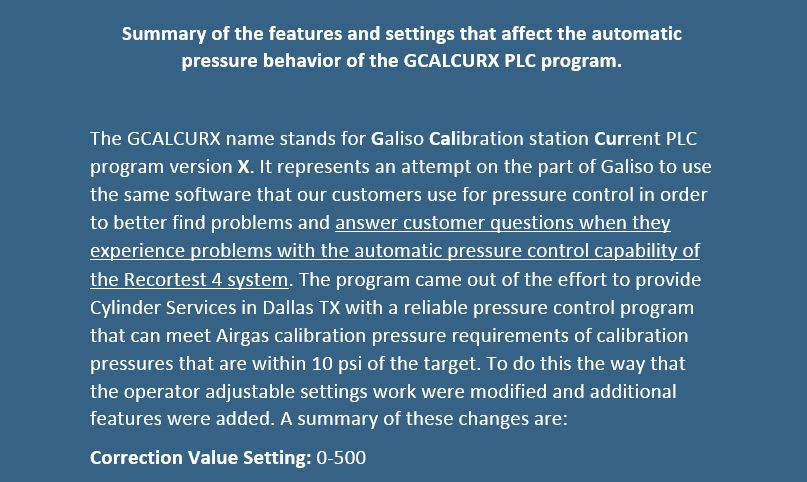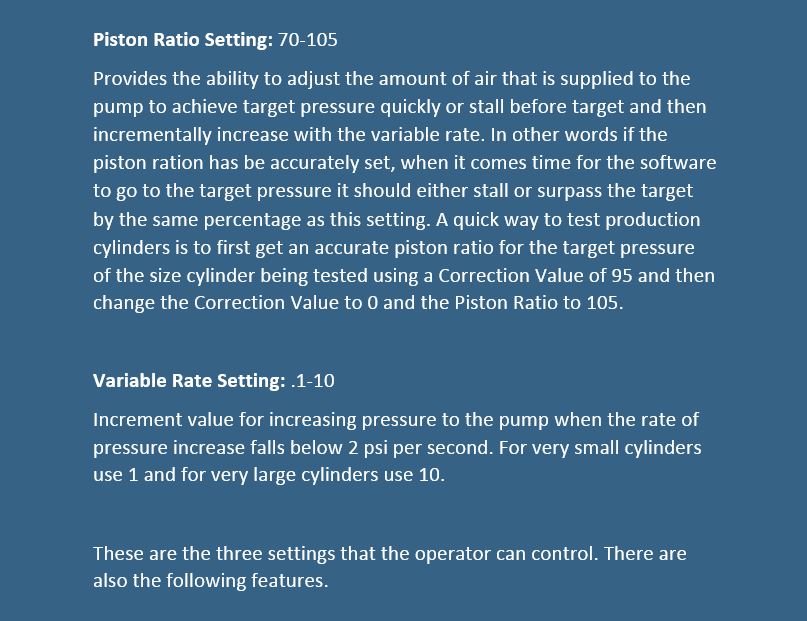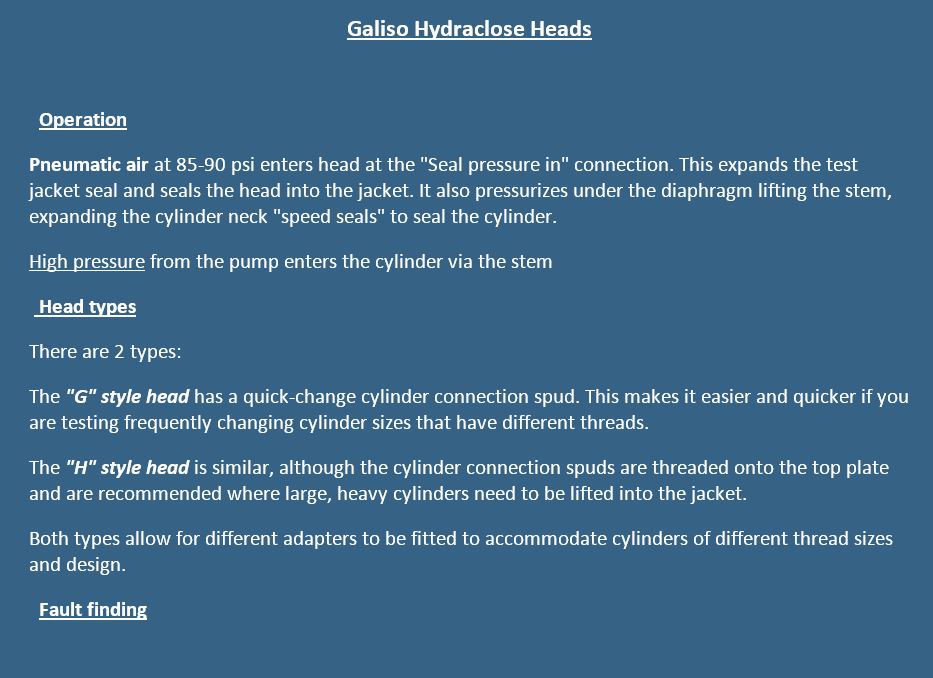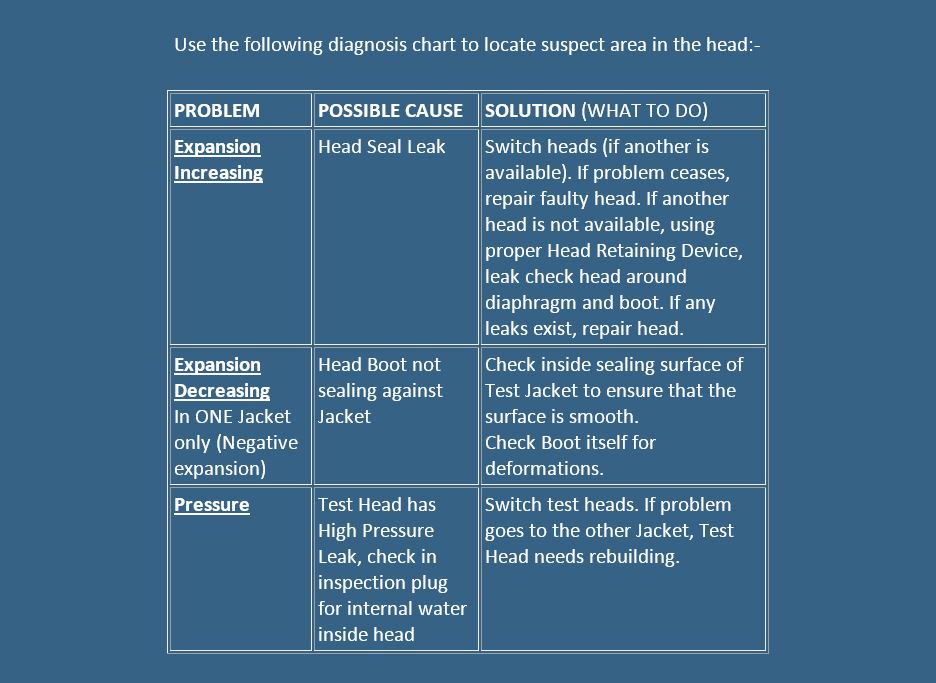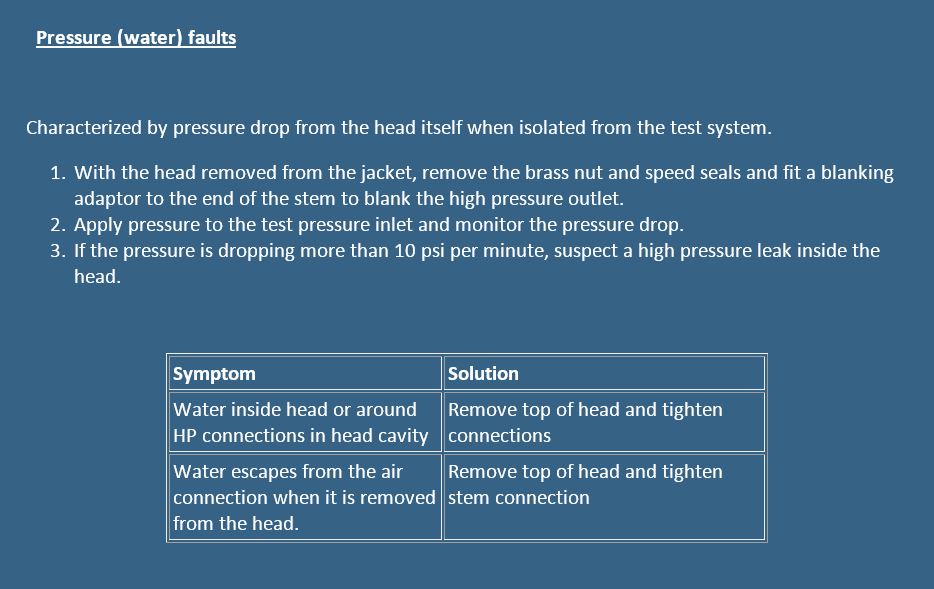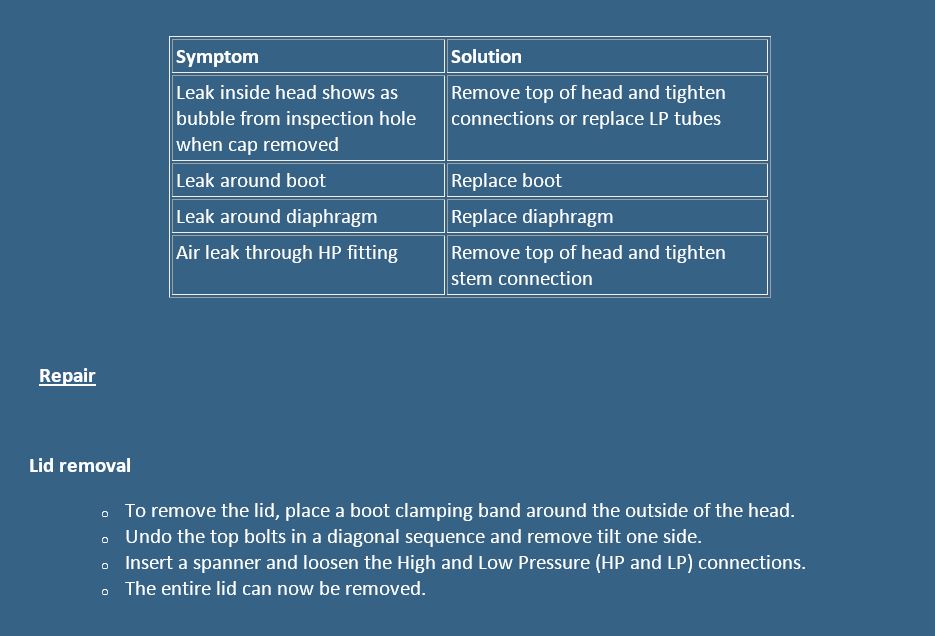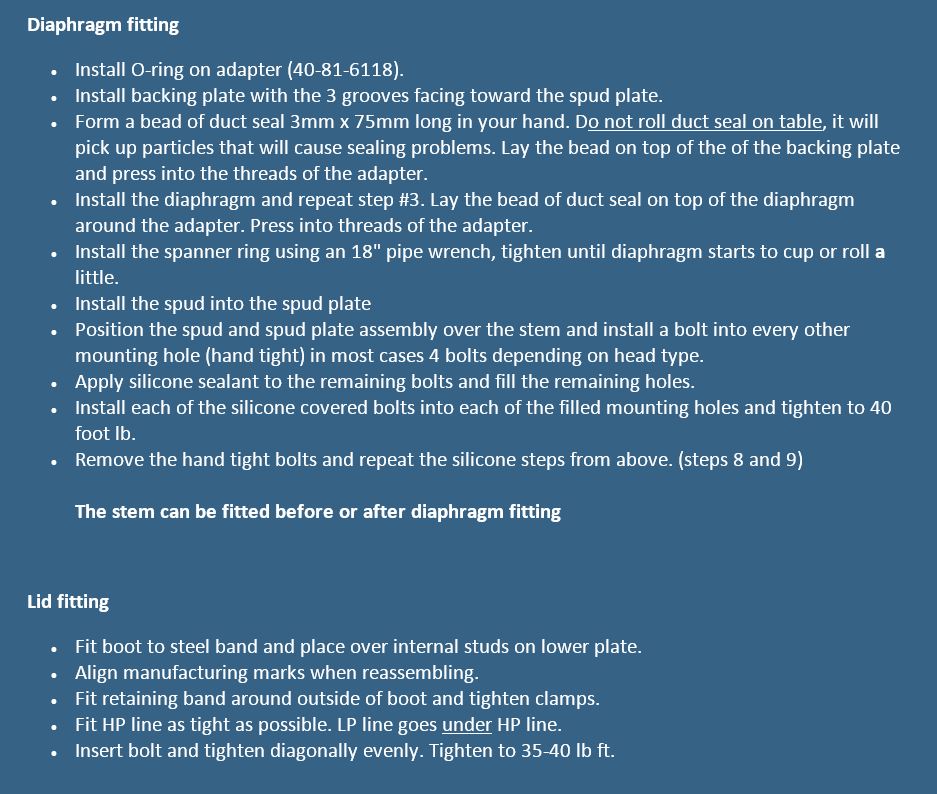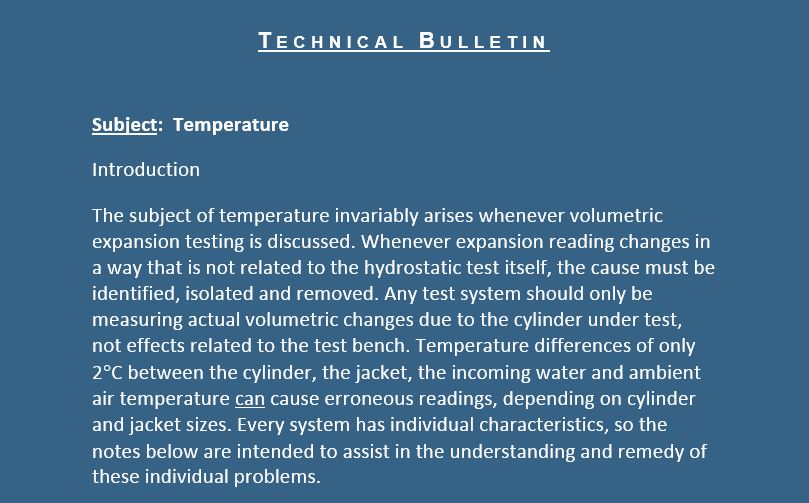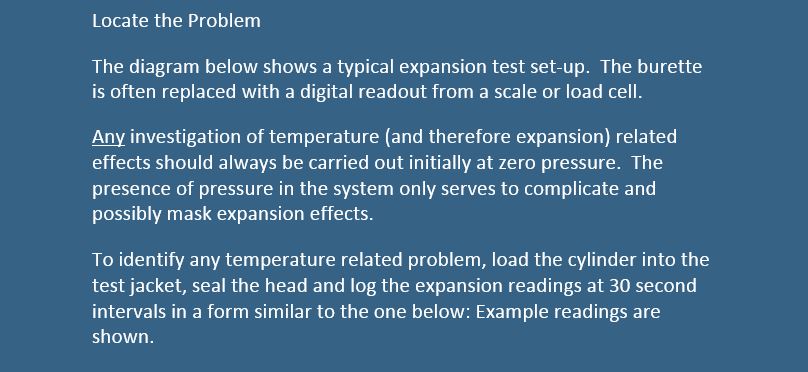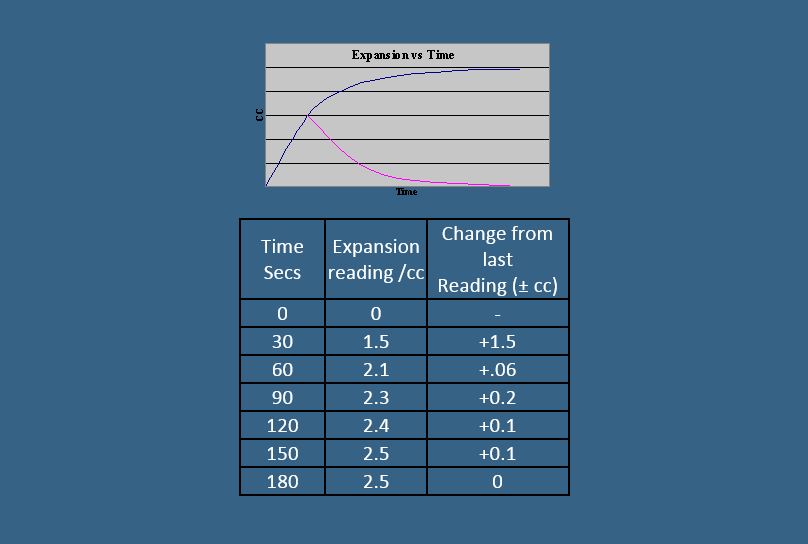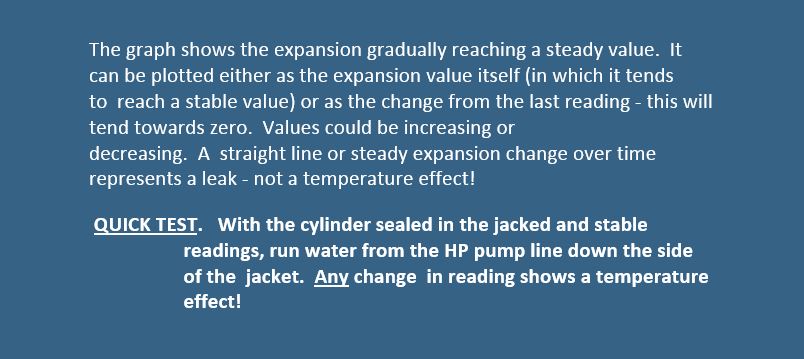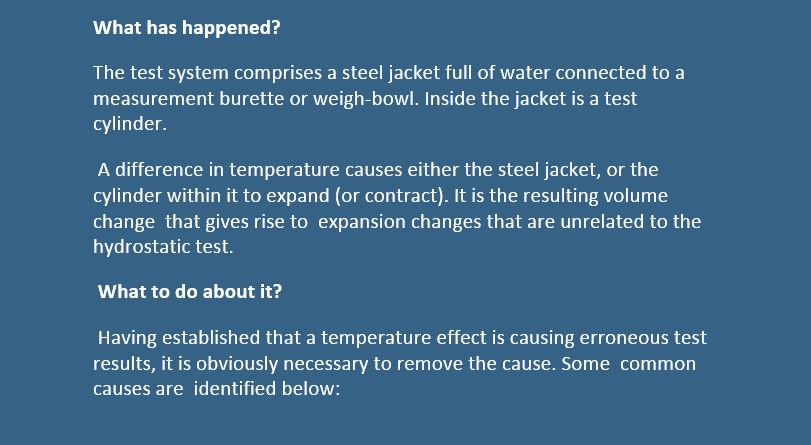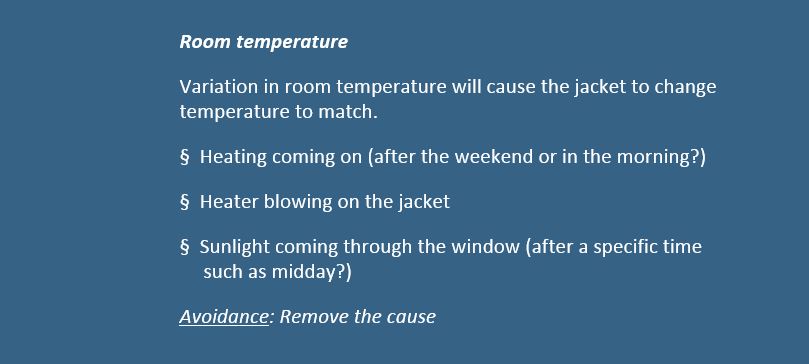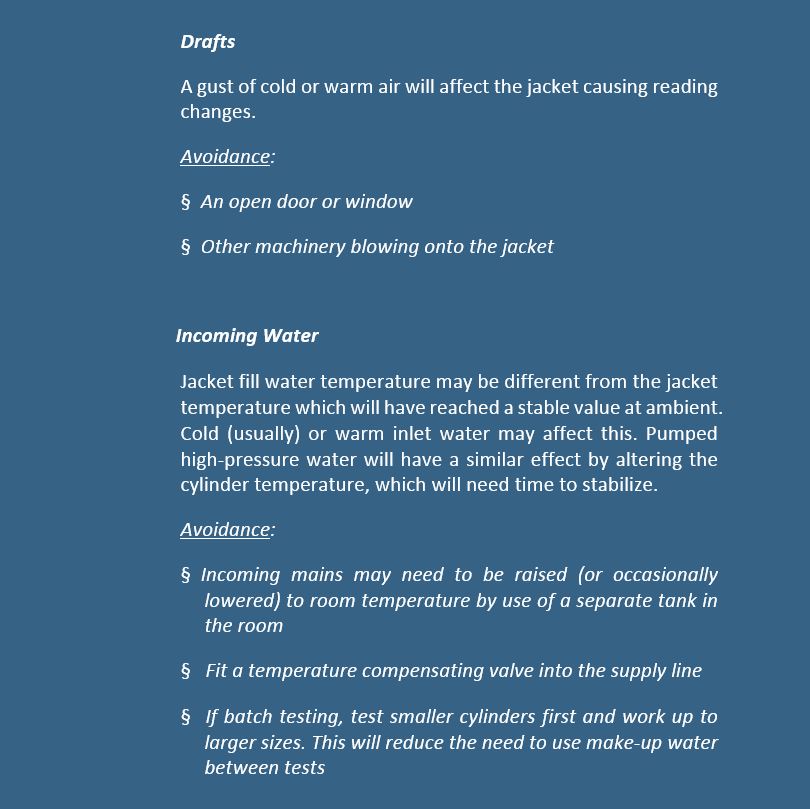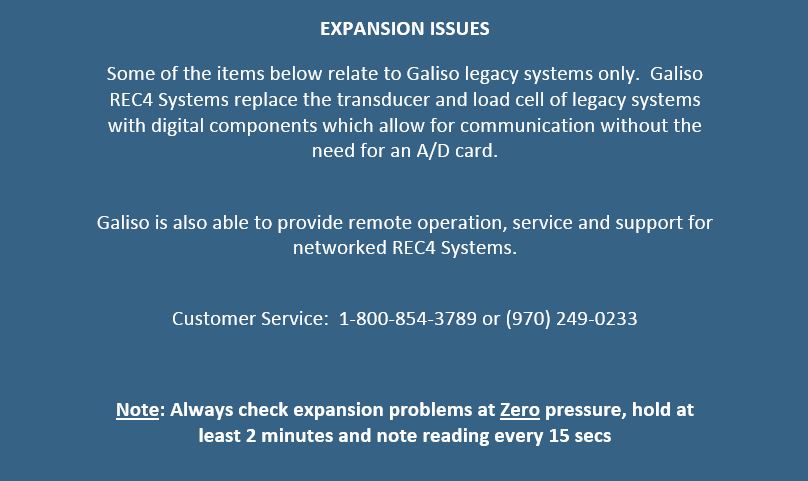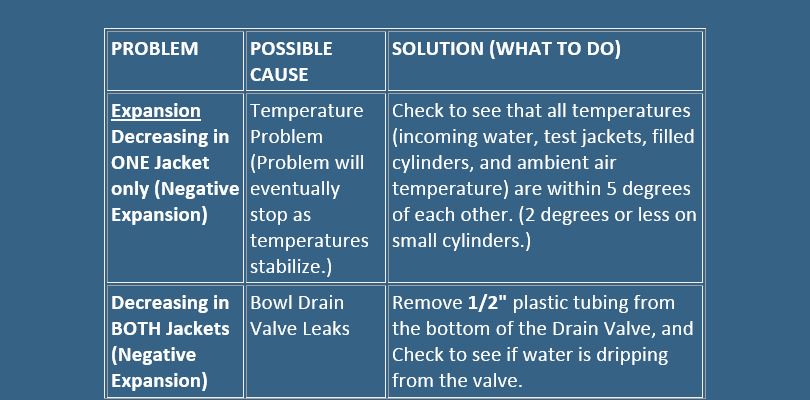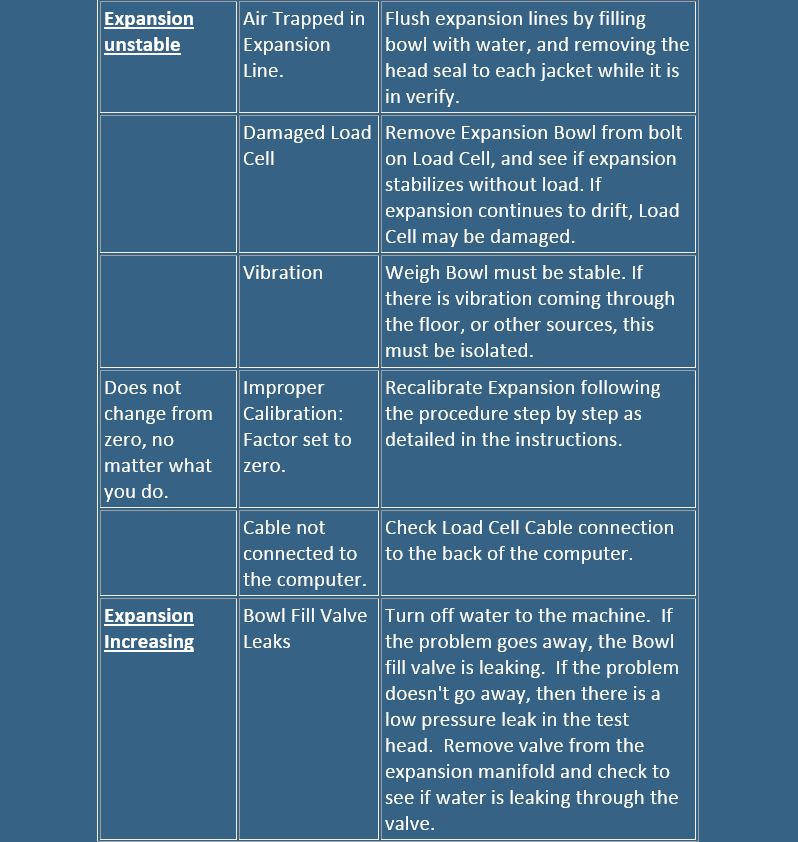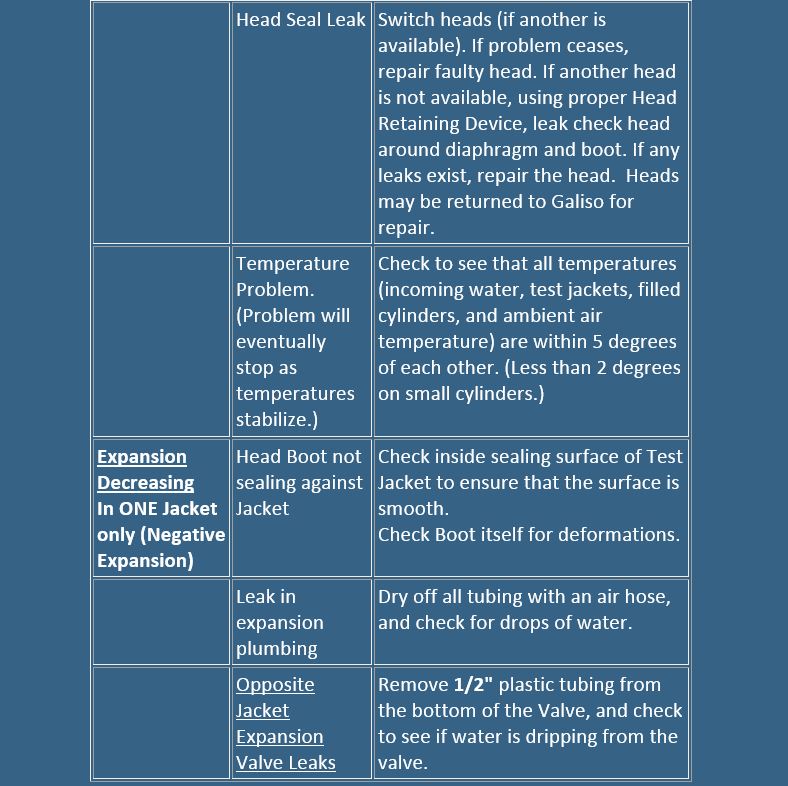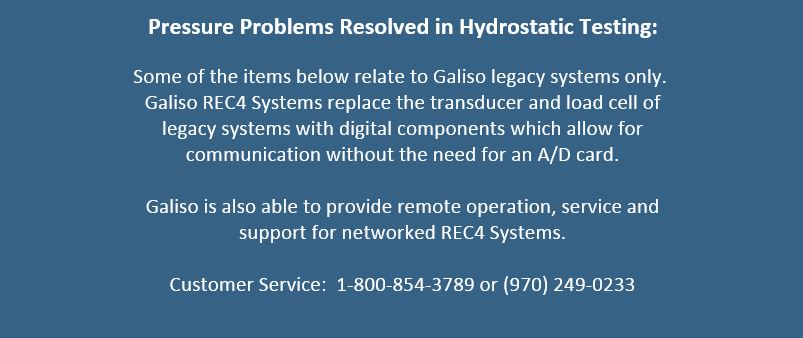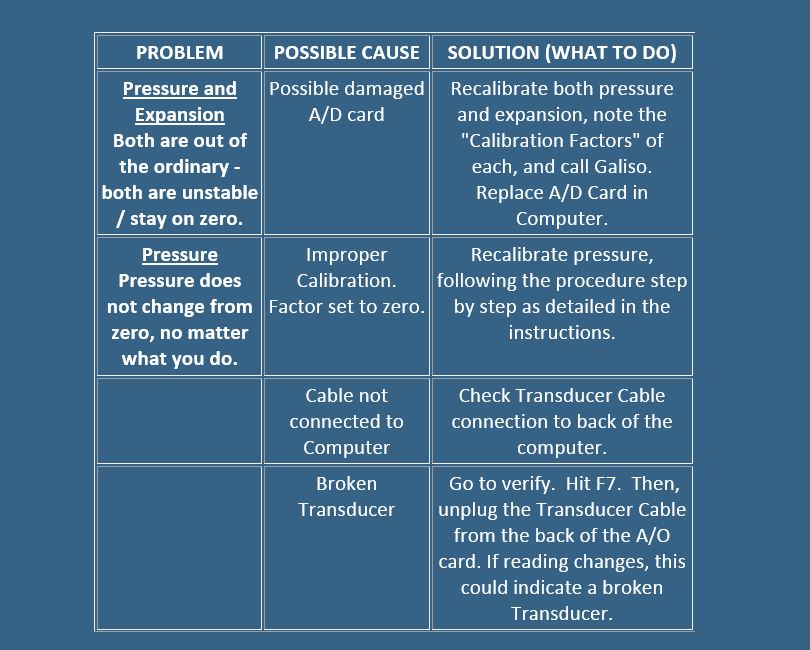Support - Welcome!
- CUSTOMER SUPPORT -
Committed to Service and Customer Support
Galiso’s Customer Service Department is dedicated to customer support. We are pleased that you have chosen Galiso, Inc. products for your test system and we are ready to provide qualified assistance. As your partner, we can help you make informed decisions.
To ensure customer satisfaction and minimize start up difficulties, our policy is to include set up and training with each automated system sale. This procedure is proven, and when our system is professionally set up, there are fewer problems towards a goal of a faster return on investment. Continuing support is vital to our commitment.
Support Solutions:
- SAFETY ALERTS -
- REC4 & REC4 OPEN SYSTEMS -
To: All Galiso Volumetric Hydrostatic Test Equipment Users
It has come to our attention that unsafe cylinders with greater than 10% permanent expansion have been returned to service with the disposition of "PASS" on the Galiso Volumetric Hydrostatic Test system report.
PASS is NOT a valid test disposition for the Volumetric Hydrostatic Test that these systems perform on cylinders that are required to pass a Volumetric Hydrostatic Test where the expansion of the cylinder is measured and evaluated.
The valid test dispositions for cylinders that are required to pass a Volumetric Hydrostatic Test are:
PPP, PPN, and PNP
The first PPP disposition indicates that the cylinder passed the visual inspection, passed the percent permanent evaluation, and passed the elastic expansion evaluation.
The second PPN disposition indicates that that the cylinder passed the visual inspection, passed the percent permanent evaluation, and that the elastic expansion evaluation is not applicable to the cylinder being tested.
The third PNP disposition indicates that the cylinder passed the visual inspection, that the percent permanent evaluation is not applicable to the cylinder being tested, and passed the elastic expansion evaluation.
Galiso Volumetric Hydrostatic Test systems use the "PASS" disposition for following purpose:
1. The positive result of a proof pressure test that does not evaluate the expansion of the cylinder being tested because no criteria was entered for evaluating the percent permanent expansion.
Please print this Safety Alert and post it next to your Galiso Test System and make sure that the operators of the Test System understand the importance of this subject.
Safety Alert PDF - To Print
- PRODUCT MANUALS -
Hydrostatic Testing Manuals:
Manuals
Calibrated Cylinders 21-11-1133F CIV Automatic Cylinder Inverter/Valver 21-11-1024 Control Box Replacement for GVMs & CIVs CRT-1 Collar Removal Tool 21-11-1060 CRT-90 Collar Removing Tool 21-11-1190 CST-25 Collar Sizing Tool Digital Pressure Gauges 21-11-1508 GCD Cylinder Dryer 21-11-1173 - Rev C GCI - Galiso Cylinder Inverter 21-11-1506 GCI Transfill 21-11-1179 GTC New Style Manual 21-11-1098 GTC Manual 21-11-1180 GTV-600 Galiso Torque Verifier 21-11-0600 GVM-16G Automatic Cylinder Valving Machine 21-11-1002 HDD-8RB Digital 21-11-1025 Rev A HDD Old Style (Legacy Product) ISB Manual 21-11-1019 LCR4 6WT 21-11-1053 LCR-6-PT 21-11-1066A LCR-6-WT-EPP Master 21-11-1065 LCR-PT 21-11-1066 LDD-4 Manual 21-11-1027 MAK-4 Manual NPT-1010 Collar Attachment Tool 21-11-1033 Opti-Lite Instruction Manual 21-11-1180 Opti-Lite Instruction Manual 21-11-1180 Rev A Oxygen Use Filter Assembly 80-11-0046 PCT ADW-D Conversion Kit 21-11-0936 PCT-30 ADW-D PCT-162 ADW-D PCT - ADW Rev E Keyboard Version 21-11-1007 PCT Soap Option 21-11-1008B PCT-ADW-D and Drawings 21-11-1009 PPT Proof Pressure Test Console 21-11-1072 Presstest System REC III Manual 21-11-1015 Rec4 – 222/224 Test System Manual 21-11-1220 REC4 Open Manual 21-11-1200 Rev A REC4 Open - Quick Reference Guide Recortest III to Rec4 Upgrade 214 Manual 21-11-1210 Recortest III to Rec4 Upgrade Manual SCD Dosing Pump 21-11-0945 SCD - Small Cylinder Dryer Instruction Manual - REV D 7/2013 SCD - Small Cylinder Dryer with Touchscreen Controller - REV E 3/2015 Test Head Instruction Manual 21-11-1063 VST-9 21-11-1021Semiconductor Industry Manuals:
Manuals
HGRS Data Acquisition Software Manual 21-11-1129 HGRS PC Recipe Editor Manual 21-11-1128 HGRS Visual Control Software Manual 21-11-1131 Hot Gas Sweep -101 Blower Unit Manual 21-11-1149 Hot Gas Sweep for Alliance PTX Etch Tool Manual 21-11-1176 Hot Gas Sweep for LAM 9600 TCP Etch Tool Manual 21-11-1156 MRP - 201 ELC Manual 21-11-1124- SOFTWARE IMPROVEMENT -
- SPEED SEAL SELECTION GUIDE -

- TROUBLESHOOTING -
Troubleshooting Articles
Welcome to Galiso's Hydrstatic Testing Troubleshooting Pages!
Here you will find online tips and troubleshooting information regarding Galiso Hydrostatic Cylinder Test Equipment.
Galiso's Customer Service Dept. also stands ready to assist you with all of your troubleshooting needs:
Customer Service Dept:
Toll Free:+1-800-854-3789 Ext. 5
Local:+1-970-249-0233 Ext. 24
Fax: 1-970-249-5675
Customer Service Email: custsvc@galiso.com
Troubleshooting Checklist
Troubleshooting Checklist PDF
Troubleshooting checklist for Galiso Hydrostatic Test Machines
Some of the items below relate to Galiso legacy systems only. Galiso REC4 Systems replace the transducer and load cell of legacy systems with digital components which allow for communication without the need for an A/D card. Galiso is also able to provide remote operation, service and support for networked REC4 Systems.
Customer Service: 1-800-854-3789 or (970) 249-0233
Note: Always check expansion problems at Zero pressure, hold at least 2 minutes and note reading every 15 secs
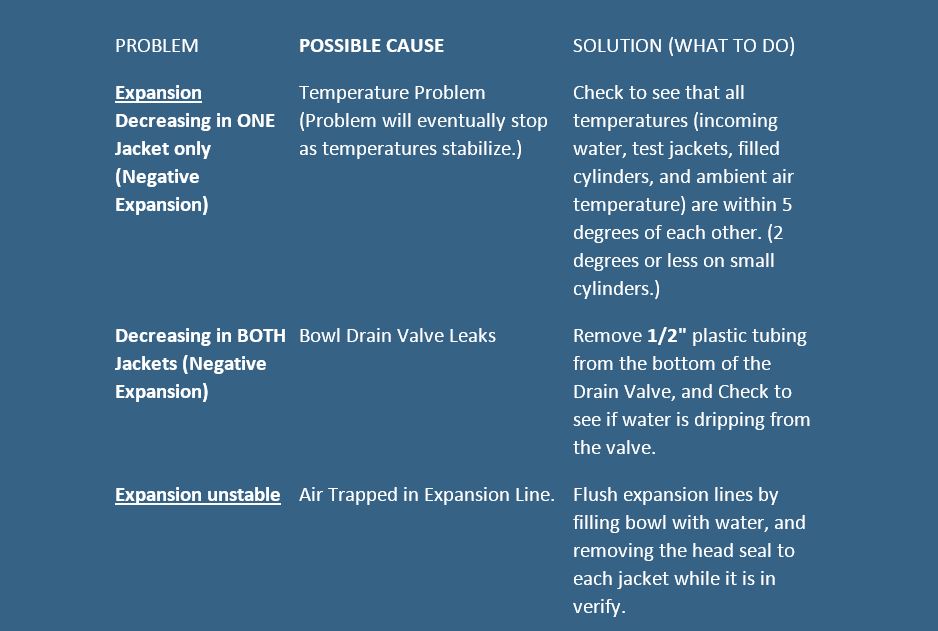
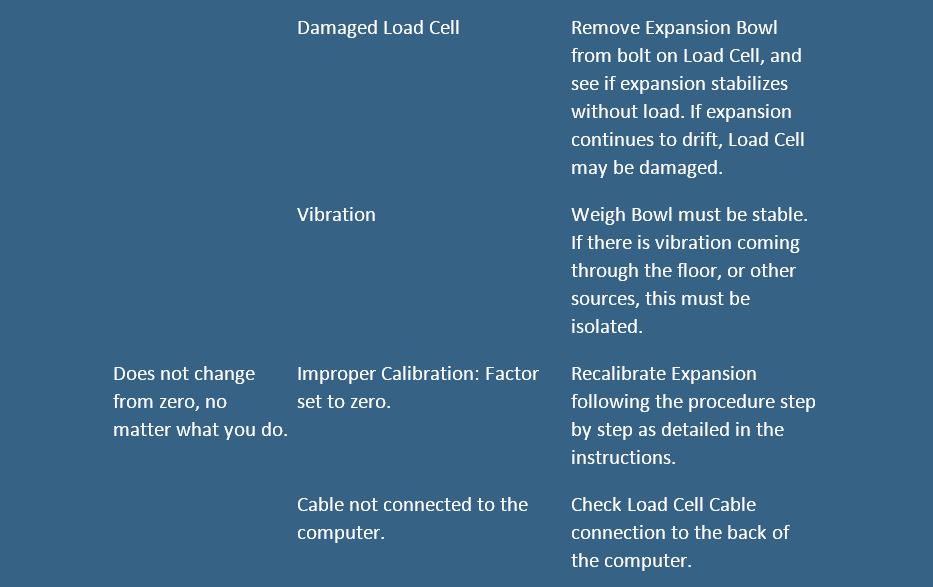
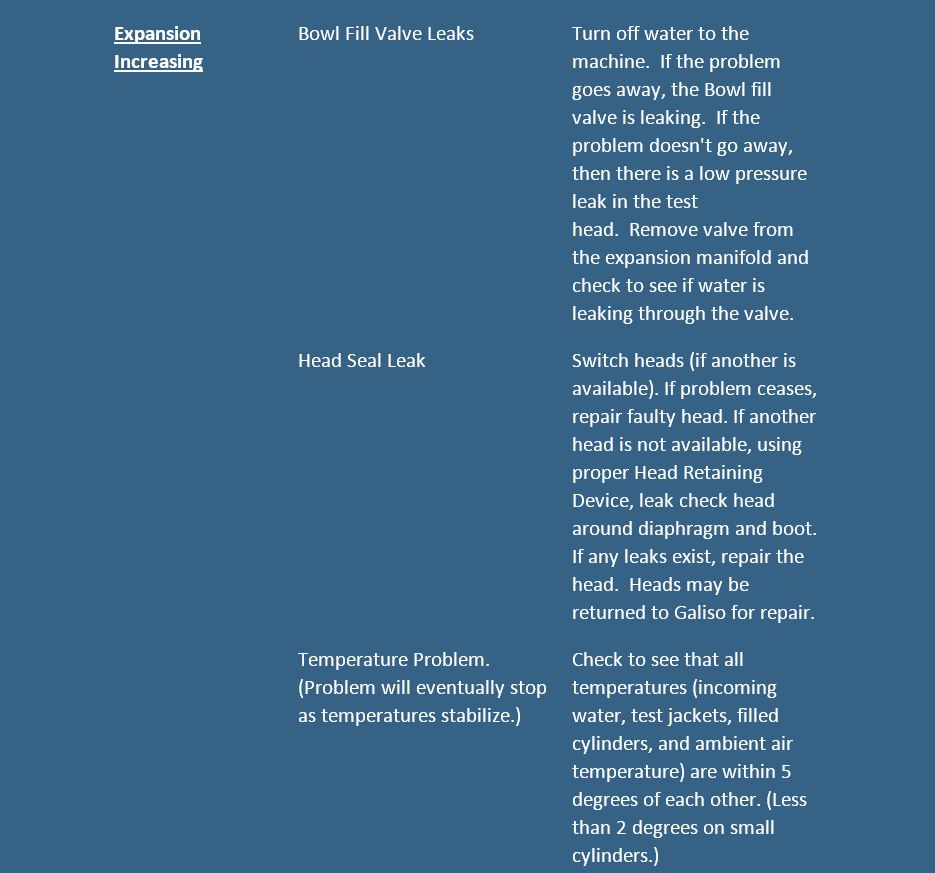
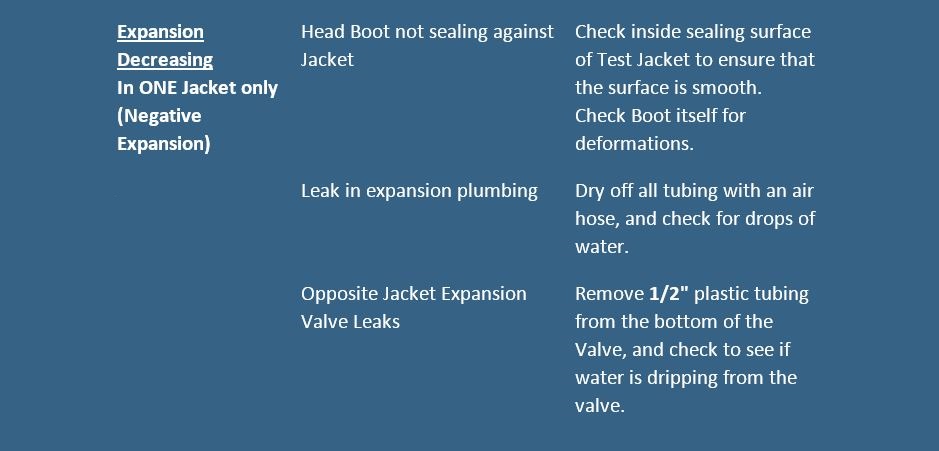
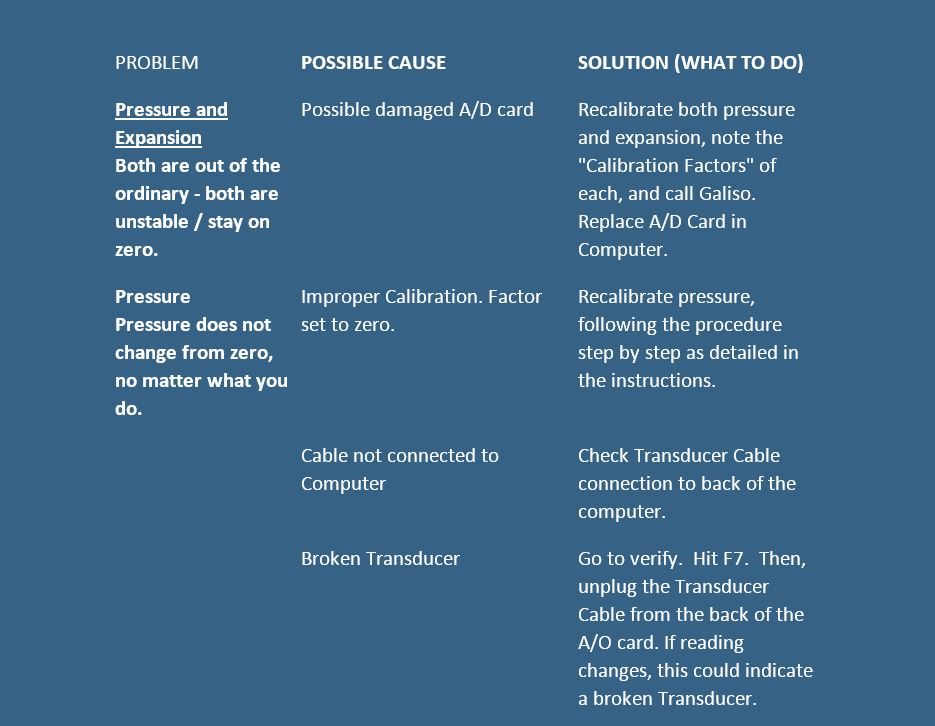
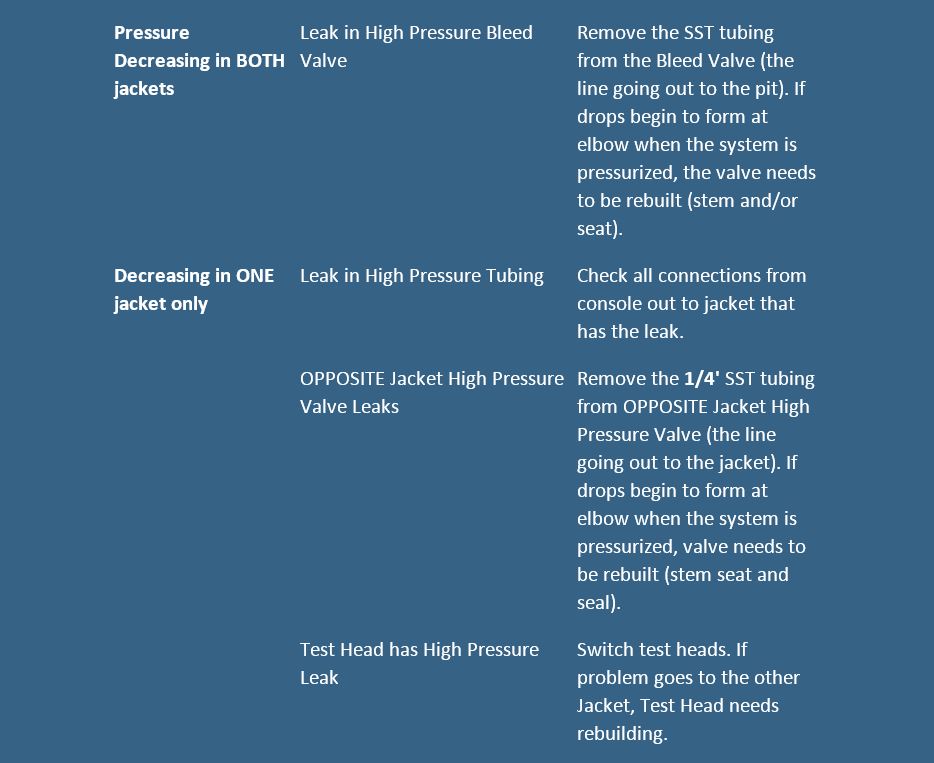

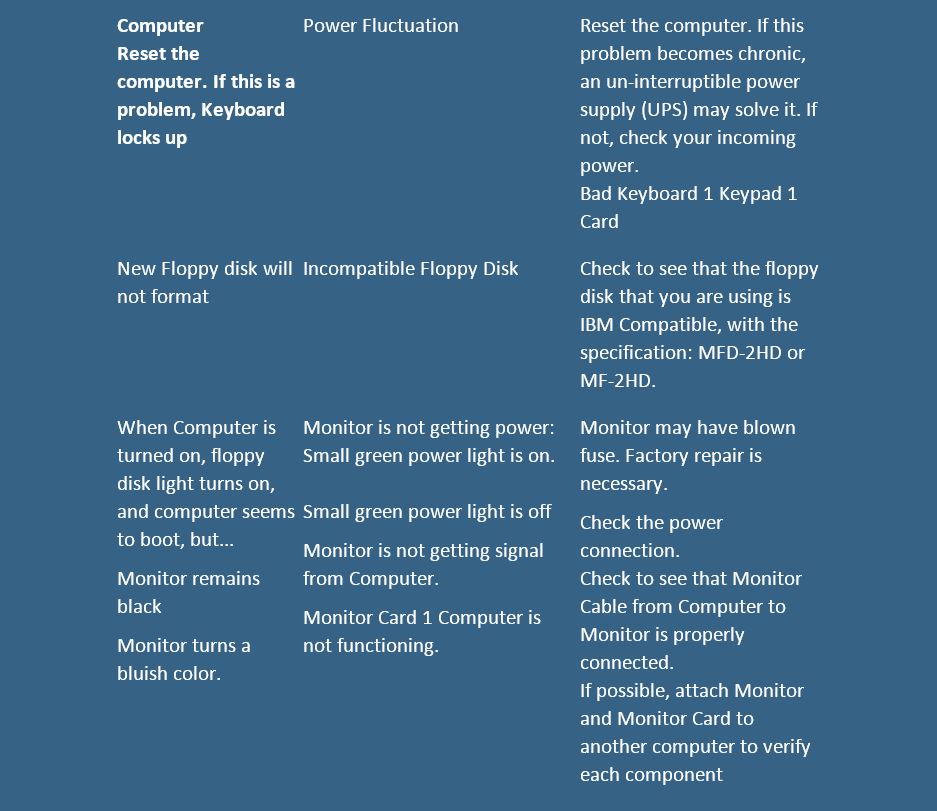
COMPUTER Issues
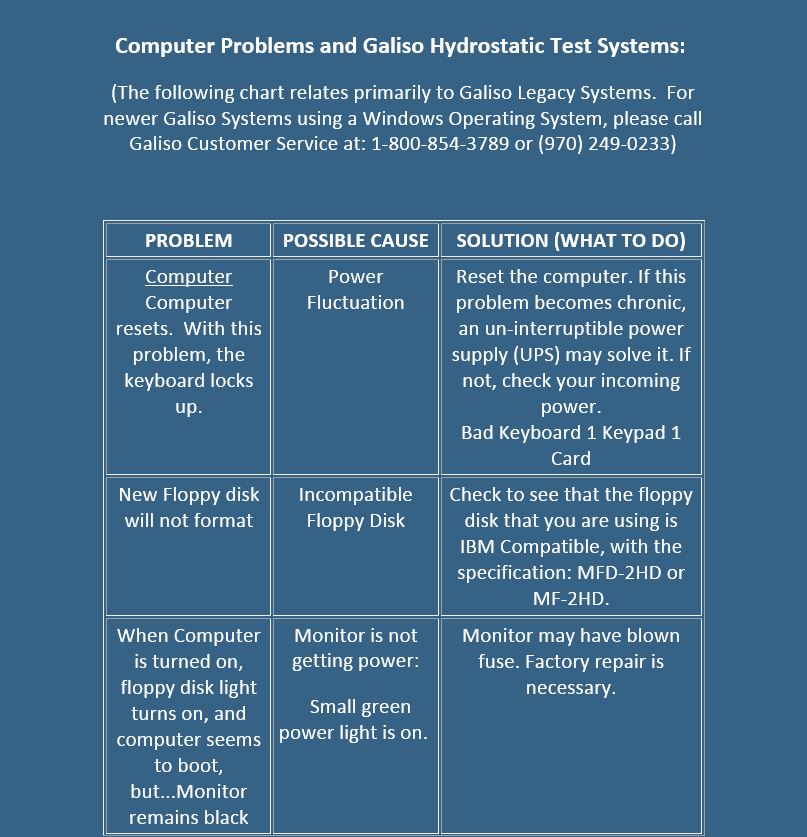
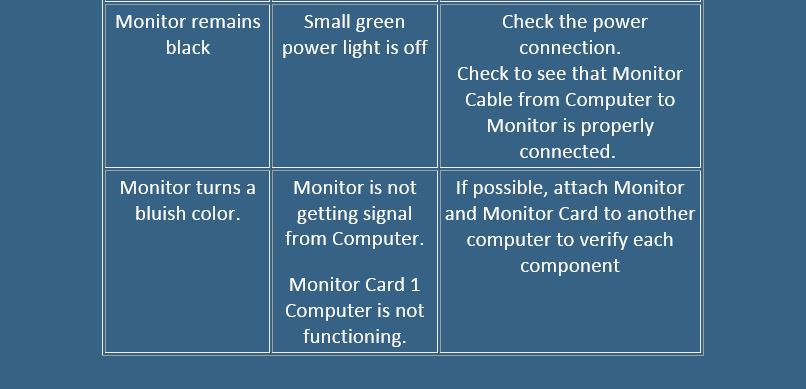
LCR-6-WT-EPP Pneumatic Control Issues
LCR-6-WT-EPP Pneumatic Control Troubleshooting- RETURN SHIPMENTS -
In the event you need to send items to Galiso for repair or return, please choose United Parcel Service (UPS) or Federal Express (Fed-X). Because we are in a small community, using another carrier could delay receipt of your shipment by days or even weeks.
And, before shipping anything to Galiso, please call our Customer Service Department to request a RETURN AUTHORIZATION (R/A) Number and to answer any questions you may have – toll free within North America at 1-800-854-3789 or you may use (970) 249-0233.
- THIRD PARTY INSPECTORS -
Independent Inspection Agencies
DOT Cylinder Re-qualification Program
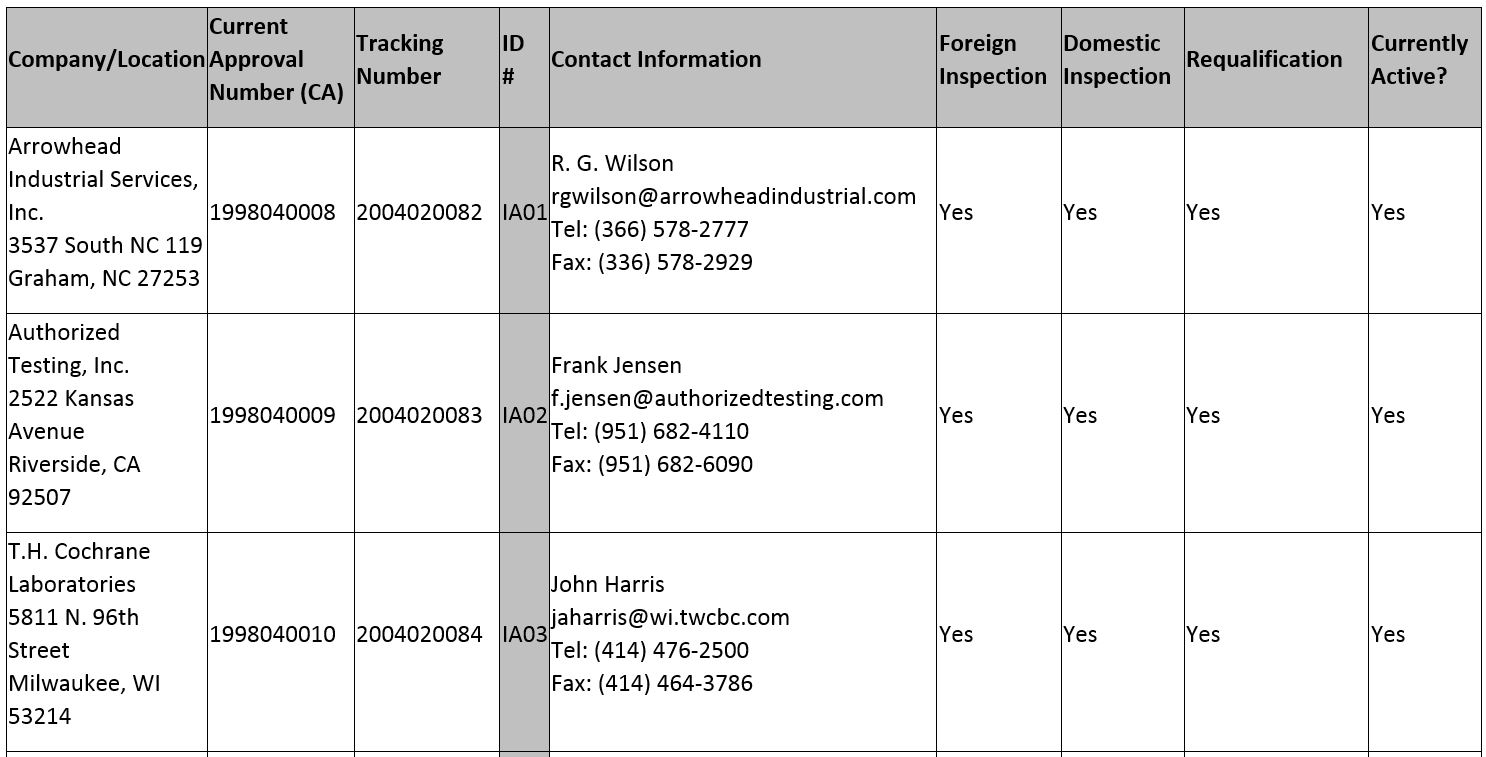
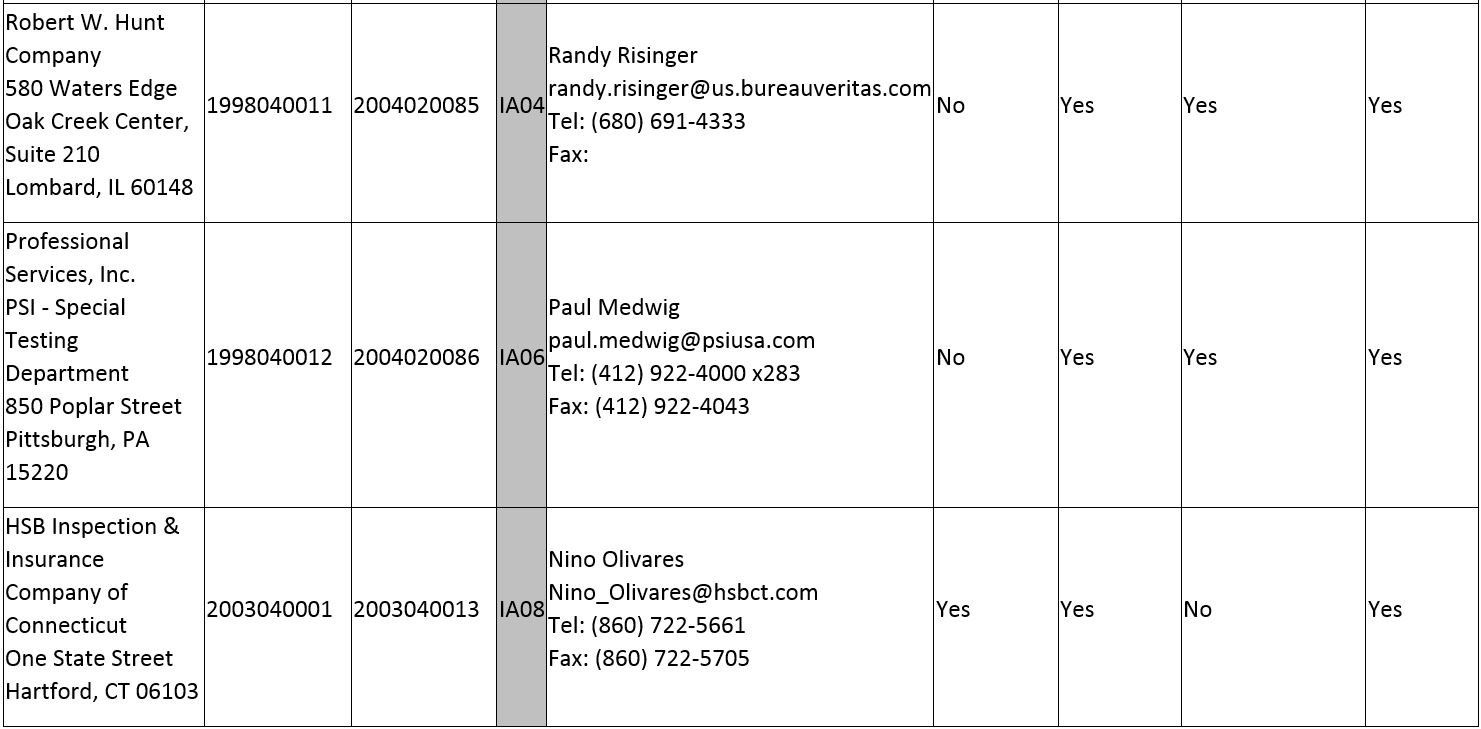


- HELPFUL LINKS -
Helpful Links:
D.O.T. Links:
Useful, external links to the D.O.T. regarding your Cylinder Re-Qualification Hazmat Training:
eCFR
D.O.T. Training Requirements
D.O.T. List of Free Publications
D.O.T. Security Training FAQs
D.O.T. Training Brochure
Hazmat Safety Programs
Canada - T.D.G. Links:
English Applicants: Registration & Renewal
French Applicants: Registration & Renewal
TC Permits for Equivalent Level of Safety
Other Helpful Links:
GALISO ONLINE STORE
- EXEMPTIONS -
Hazardous Materials Safety Administration
Current and Frequently Requested Special Permits
To view a special permit, visit the following U.S. Government Search Page and enter the Number (no letters) of the permit you are looking for:
SPECIAL PERMITS SEARCH
- GALISO WARRANTY -
Hot Gas Sweep Product & Technology:
- HGS®: Hot Gas Sweep -
HGRS / HGS BACKGROUND INFORMATION
- INTRODUCTION AND CLAIMS -

The Process
HGS® is a proven technology developed to improve semiconductor tool performance. The patented Hot Gas Sweep pulsates a hot, high velocity viscous gas flow to the load lock and process chamber sweeping out particles and expelling them via the process pump by this volume of gas.
Particle Management System
Over the years recognized leaders in the semiconductor industry have seen remarkable improvements in wafer production, die, yield, and cost containment by the application of HGS® to their LAM 9600 TCP tools.
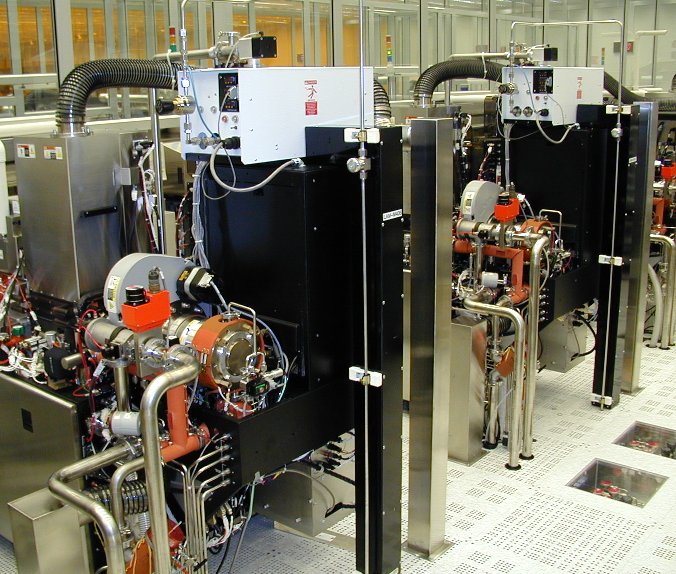
Here's how HGS® can Benefit your FAB:
Reduce Cost of Tool Ownership
Extended MTBC
Reduce Particle Contamination
Greater Virgin Yield
Improved Chamber Seasoning and Conditioning
HGS® users are experiencing 1.5 to over 3 times improvement in Mean Time Between Cleans
RF hours have increased to over 300 hours on average.
Greatly reduced particle contamination has confirmed die yield increases of 1% to 2% in most applications.
HGS® (Hot Gas Sweep) is a unique, patented, vacuum chamber processing technique that is receiving critical acclaim in the United States Semiconductor Industry because of the dramatic improvement it is providing in three areas:
The improvement of virgin yield at final sort by 2% to 5%.
The extension of Mean Time Between Cleans by a factor of 2 to 4.
The improvement of pump down times after wet cleans by at least 50%
The above results have been achieved by three distinct applications of HGS® :
In-Situ particle removal from process chambers.
Abatement of H2O and HBr in load locks.
Expedited contaminant removal from chambers after process excursions and wet cleans.
Galiso realizes that the above claims are dramatic. However, we invite you to visit our HGS® Fab Results for customer supplied HGS® processing results.
Additionally, please visit the HGS Development History to learn how HGS® was developed and proven effective.
To review the physics of HGS® Processing, please visit our Technology Overview below to learn what steps need to be taken to bring the benefit of HGS® to your Fab.
- TECHNICAL OVERVIEW -
Technical Overview HGS Chamber Processing
This page is a review of the fundamental physics associated with the use of HGS®. Please refer to our Successful HGS® Implementation for recommended steps for implementing HGS® at your facility.
Traditional Chamber Processing
The traditional industry method of removing moisture from the inside of a process chamber (See figure 1) has been to apply heat via custom heating blankets, heat tape, or internal radiant heaters, while also pumping on the chamber until the desired base pressure is obtained. This method, which slowly desorbs molecular water from the chamber walls, transports the water molecules via random molecular flow to the inlet of the vacuum pump. Random molecular flow by its nature allows water molecules and particulate to bounce around the chamber randomly until they eventually find the pump inlet. Random molecular flow occurs when the vacuum system lacks a transport medium to carry water molecules and particulate out of the chamber after they have been freed from the chamber walls. This process of bake out is well documented as requiring hours, and in some cases days, to evacuate and qualify a chamber for processing.
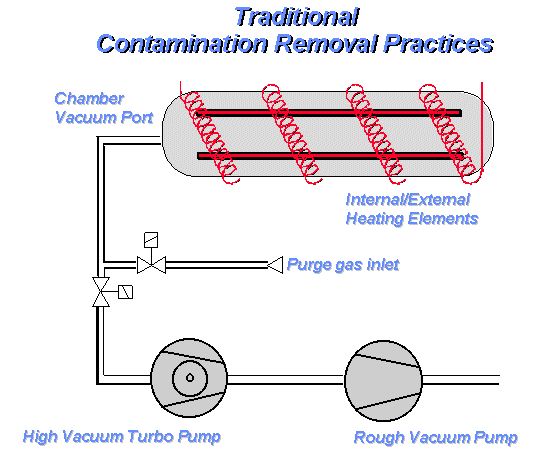
Figure 1
HGS Chamber Processing
HGS® technology quickly removes moister and particulate from chamber walls by applying heat and kinetic energy directly to the inside of the chamber, while also providing a transport medium for removal of contaminants. This technology uses three features:
1. The Low Pressure HGS® Mode heats the inside chamber surfaces via a hot viscous gas flow, thereby freeing moisture and particles from the inside surfaces, entraining them in the viscous flow, and sweeping them out of the chamber.
2. The Low Pressure HGS® Mode operates within a programmed upper and lower temperature band while gently pulsing the chamber via pressure oscillations, thus further dislodging moisture and particulate and entraining them into the viscous gas stream.
3. The CFP Mode cools the inside surfaces of the chamber to ambient temperature while maintaining viscous flow and sweeping out residual contaminates.
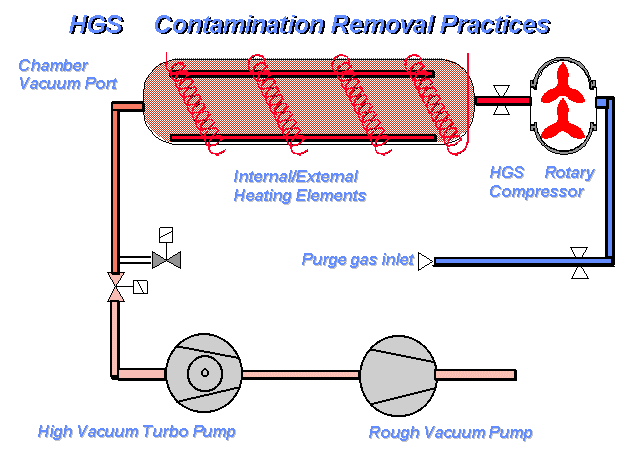
Figure 2
- SUCCESSFUL HGS® IMPLEMENTATION -
Steps Toward Successful HGS® Implementation
Because HGS® is such a dramatic shift in conventional chamber processing methods, and because the impact of HGS® technology is so significant, it often requires that a variety of Fab Operating, Process and Financial personnel become familiar with the technology and have a Q & A session. After the orientation, the entire group will have a proper understanding of the technology, and its financial impact, to determine where they would like to start.
Consequently, our most successful customers have invested in an initial 1 to 2 hour HGS® project team that championed the implementation of HGS®. At a minimum, the teams typically consist of an Equipment Engineer and an Equipment Technician from each tool group wanting to implement HGS®. The teams are often supported by a single representative from Facilities Engineering.
Establishment of the HGS technology team
After the orientation, our most successful customers have selected an HGS® project team that championed the implementation of HGS®. At a minimum, the teams typically consist of an Equipment Engineer and an Equipment Technician from each tool group wanting to implement HGS®. The teams are often supported by a single representative from Facilities Engineering.
Orientation at Galiso
The team attends a 3-day intensive seminar at Galiso's Colorado facility that covers HGS® application issues. The background received at the seminar greatly assists in the quick implementation of HGS® at the Fab. The Following topics are addressed.
Tool conductance limitations, gas flow path, entry and exit locations, analytical instrumentation requirements, and utility requirements.
Tool pressure and temperature interlocks, the capacity of the rough pump, N2 gas flow pressure and volumes, and IO requirements, are discussed in relation to how and when HGS® is to be run on the tools. PLC requirements are also addressed.
The project team receives hands-on experience operating HGS® on a tool chamber. The ability of HGS® to remove particulate and moisture is demonstrated.
HGS Application Assessment and Facilitation
During the first few HGS® applications, most customer have found it very beneficial to have one of Galiso's Field Engineers come to the Fab to assess the specific tool to which HGS® is to be adapted. We typically meet with the Team to ensure that the HGS® kit and the facility requirements are properly defined for the specific tool receiving the HGS® unit.
Each tool is then facilitated by the customer, per the requirements defined during the Orientation at Galiso and the Application Assessment. This effort involves the installation of short runs of vacuum piping from the HGS unit to the chamber entry point, electrical power supply, CDA and N2 supply, and the installation of the HGS® kit.
HGS Start-up Services
Once the tool sets are facilitated, Galiso will conduct the initial start-up and characterization of HGS® on the tool. This effort typically requires a minimum of 3 days for tools with 1 type of chamber, and 1 additional day per each different chamber type on the tool. When the characterization is done, the proper HGS® flows, pressures, and process times have been defined and an "on demand" optimized HGS® processing recipe is now available for the tool.
- TYPICAL HGS® APPLICATIONS -
Typical HGS® Applications
Etch Chambers
HGS has the ability to cause one to completely rethink how to condition a vacuum chamber both prior to staring wafer processing and during the wafer run. The more one understand the principles of HGS the more applications come to mind. We invite you to review this brief summary of typical applications and then attend one of our Seminars to become fully acquainted with the powerful results HGS can bring to your semiconductor manufacturing applications.
Slower build up on the walls extends the time to when the build up fractures, peels and falls onto the wafer.
Reducing the total population of particulate available to land on the wafer, by removing free particulate created by the etch process, creates an environment where fewer particles are available to land on your wafer and cause blocked etch problems.
Centura® is a registered trademark of Applied Material Inc.
Load Locks
HBr Abatement
The common problem of HBr back-streaming and out-gassing into the load lock as wafers are moved from the process chamber into the Load Lock, is deftly addressed through the application of HGS. The turbulent, viscous flow of heated HGS gas quickly removes HBr from the load lock and degasses wafers. Beta test at a Dallas Texas Fab demonstrated an extended life of the cassette handlers by a factor of 2, and also eliminated daily wipes of the load lock. Lastly, and perhaps most importantly, this HGS application reduces the health risk associated with exposure to HBr.
Moisture Abatement
Load Locks are the single most significant source of entry for atmospheric contaminants during the semiconductor manufacturing process. The entry of atmospheric moisture into the load lock, and the subsequent migration of moisture into buffers and process chambers can adversely affect processing conditions. The use of HGS through the load lock on a periodic basis will eliminate this migration pattern and extend the life of the manufacturing cycle.
Preclean Chambers
Being essentially an etch chamber, HGS can bring the same benefit of the above Etch chamber summary to a preclean chamber. A cleaner preclean chamber minimizes the migration of contaminants to the processing chambers of a high vacuum tool.
- HGS® DEVELOPMENT HISTORY -
Galiso's HGS® History:







Further Development History:
AMAT Magazine
Before & After HGS®
AMAT Memo
HGS® Patent
- GRAPHICS OF PRODUCTS -
Graphics of Products
Galiso's HGS® Unit is a state of the Art system for Semiconductor Industry solutions that have seen remarkable improvements in wafer production, die, yield, and cost containment.
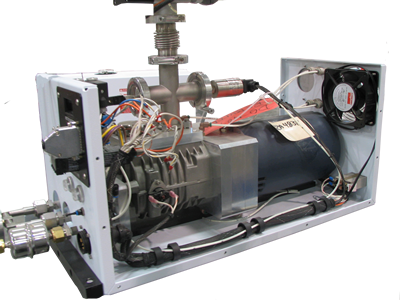
HGS® Unit
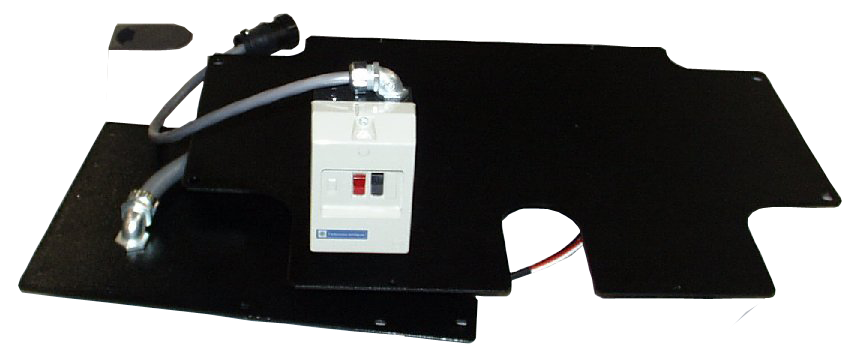
TCP Controller Mounting Kit
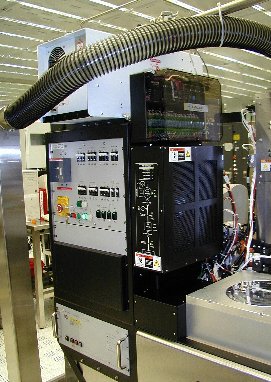
TCP 9600 Kit Installed
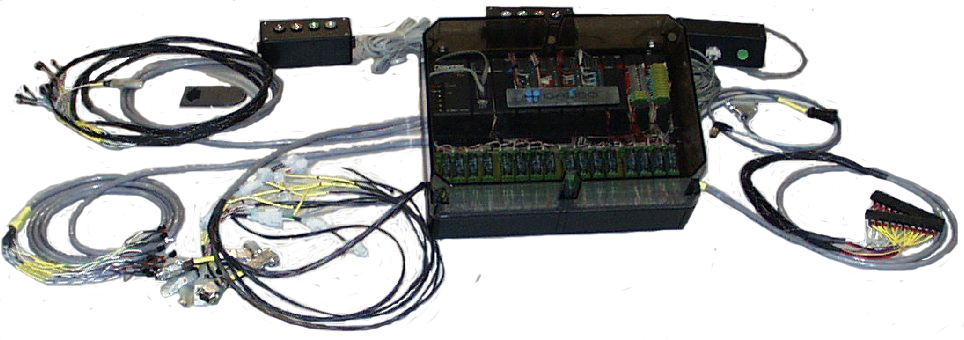
TCP 9600 Controller Kit
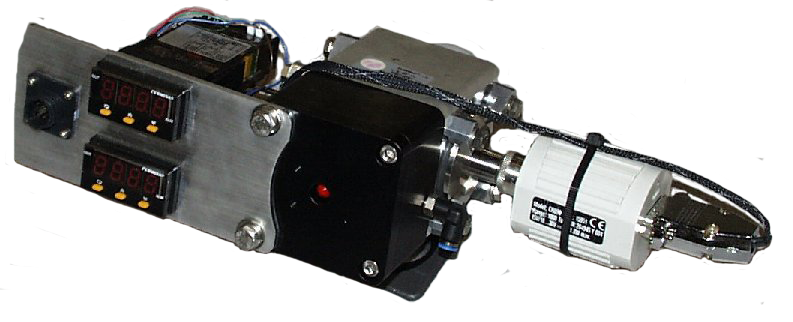
TCP Instrument Cross with Valve Block
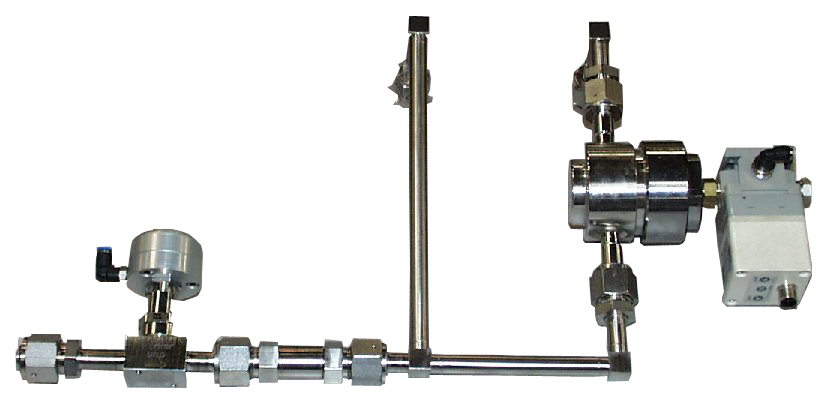
TCP Gas Stick
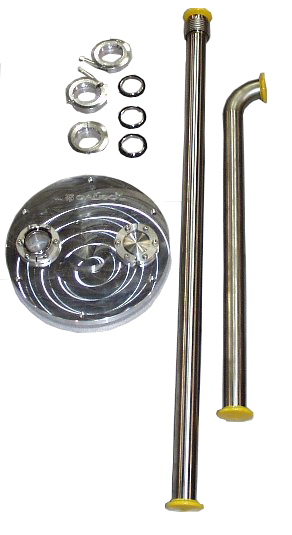
TCP Process Interface
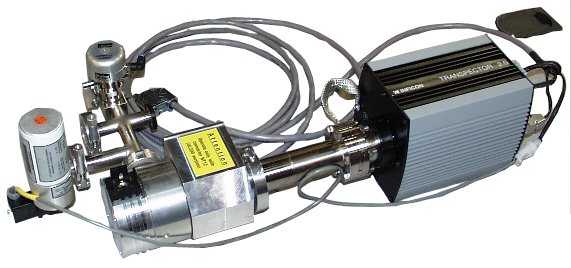
TCP RGA Kit
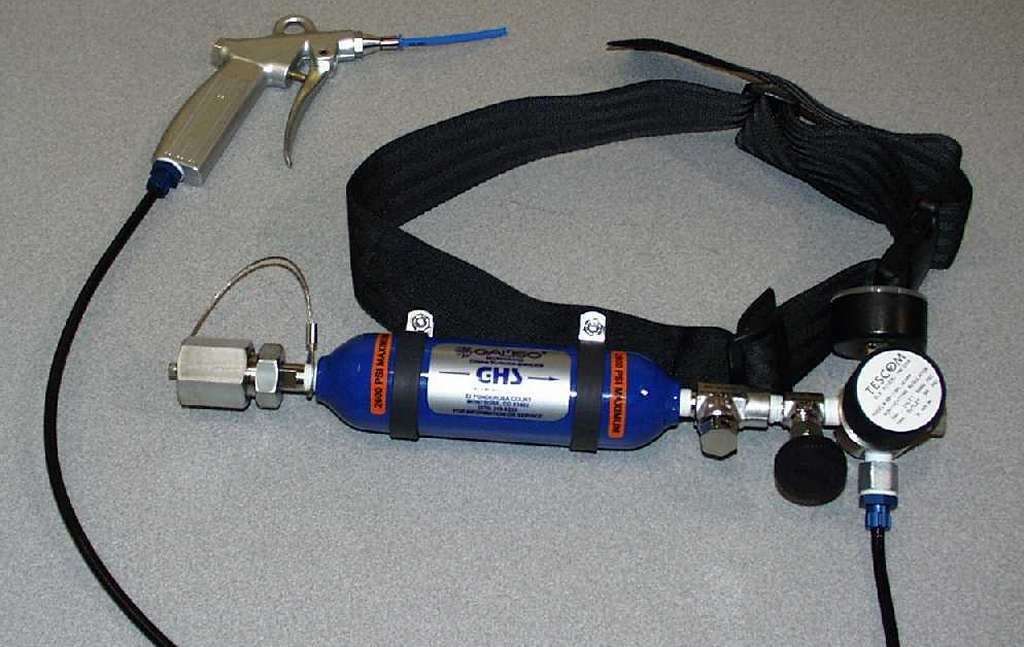
GHS Helium Spray System
Contact Us

Galiso Inc.
22 Ponderosa Ct.
Montrose, CO., 81401
U.S.A.
Sales:
800-854-3789 Ext. 6
970-249-0233 Ext. 74
Fax: 1-970-249-0607
Sales Email:
sales@galiso.com
Customer Service:
800-854-3789 Ext. 5
970-249-0233 Ext. 73
Fax: 1-970-249-0607
Customer Service Email:
custsvc@galiso.com

